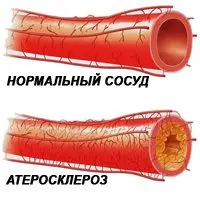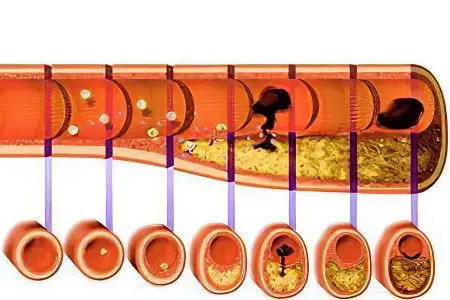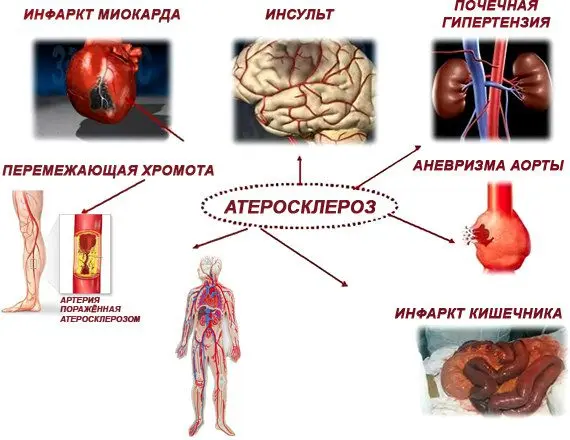Contents
What is atherosclerosis?

Atherosclerosis is a chronic disease of blood vessels, in which “bad” cholesterol and other LDL are deposited on their inner wall in the form of deposits and plaques, and the walls themselves become denser and lose elasticity. The vessels gradually become hard due to the settling of fats and lime on the walls, lose their elasticity and, as a result, narrow, which reduces the access of blood to the organs. Eventually, the vessel may close completely. And when this is accompanied by a violation of blood clotting, then there is a tendency to thrombosis and ischemic damage to organs occurs.
Atherosclerosis is considered one of the most dangerous diseases that leads to death. Atherosclerosis is recognized, most often when problems with the blood supply to the heart, limbs and brain already appear, that is, the disease is diagnosed in the last stages. Atherosclerosis is one of the main causes of cardiovascular diseases: coronary heart disease and myocardial infarction.
The percentage of people with atherosclerosis increases depending on their age, i.e. this disease is typical for older people. Therefore, doctors call it an senile disease, but every year it gets younger, which is associated with a modern lifestyle.
[Video] Dr. Evdokimenko – the true causes of plaques on the walls of blood vessels, preventive measures:
Symptoms of damage to the vessels of the upper and lower extremities
Symptoms are as follows:
Feeling cold (chill) in the hands or feet;
Feeling that “goosebumps” run down the arms or legs, as after a long stay in the same uncomfortable position (“leakage”);
Paleness of the skin: the skin takes on a deathly pale color and a vascular pattern is clearly visible (marble-colored skin).
In the later stages of atherosclerosis of the vessels of the extremities, more severe manifestations occur:
Degeneration of tissues that receive an insufficient amount of necessary substances (thinning of the fat layer, irreversible hair loss);
Pain in the limbs. In the case of damage to the arteries of the legs, the so-called “intermittent claudication” is observed. The pains are localized in the thighs, buttocks and calves and are paroxysmal in nature, as a result of which the patient begins to limp;
The formation of wounds on the legs (trophic ulcers associated with a lack of tissue nutrition);
Redness of the fingers or toes, development of persistent edema;
Tissue necrosis (gangrene).
Symptoms of cerebrovascular disease
It is most susceptible to malnutrition, however, the primary symptoms are characteristic not only of atherosclerosis. So, problems with cerebral circulation are observed with osteochondrosis, vertebrobasilar insufficiency, etc.
Symptoms appear gradually, in increasing order:
Cephalgia (or headache, unspecified). Covers the entire head without the ability to determine the exact localization. Has a bursting or pressing character;
Ringing and noise in the ears;
Sleep problems. A person suffers from insomnia, or vice versa, he is constantly sleepy. During sleep, heavy or nightmare dreams often occur (which is associated with brain activity and diffuse changes due to lack of blood circulation);
Deterioration of a person’s character (changes in personality);
Nervousness, high excitability, increased anxiety;
Lethargy and fatigue;
Violations of the basic functions of the body: breathing, speech, nutrition. The person may speak indistinctly, often choke on food, etc.;
Disturbances in coordination of movements, problems with independent movement and orientation in space (due to damage to the cerebellum).
Causes of Atherosclerosis
The causes of atherosclerosis are high blood pressure, smoking, diabetes, high blood cholesterol. But the main cause of atherosclerosis is a violation of cholesterol metabolism. The formation of atherosclerosis is a natural process that begins at about 10–15 years of age. With age, it can slow down, or it can speed up.

There are the following risk factors for the development of atherosclerosis:
Floor. Men are more prone to developing atherosclerosis than women. The first signs of this pathology can appear already from the age of 45, or even earlier, in women – from the age of 55. Perhaps this is due to the more active participation of estrogens in the metabolism of cholesterol and low and very low density lipoproteins;
Age. This is a natural risk factor. With age, atherosclerotic manifestations worsen;
Наследственность. Of course, this is one of the causes of atherosclerosis. Atherosclerosis is a multi-causal disease. Therefore, the level of hormonal levels, hereditary dyslipoproteinemia (violation of the plasma lipid profile), the activity of the immune system play an important role in accelerating or slowing down the development of atherosclerosis;
Bad habits. Smoking is a poison to the body. This habit is another reason for the development of atherosclerosis. If you want to have healthy blood vessels – stop smoking! As for alcohol, there is an interesting relationship: the use of small doses of alcohol – about 50 g of vodka, 100 g of wine or 0,5 liters of beer daily is an excellent prevention of atherosclerosis. True, the same dose contributes to the development of cirrhosis of the liver. So we treat one thing – we cripple another. But large doses of alcohol accelerate the development of atherosclerosis;
Overweight. This factor increases the likelihood of atherosclerosis. Obesity can lead to diabetes, and this pathology is a direct path to atherosclerosis;
Incorrect food. Fatty, junk food is a major risk factor. Eating is a very important physiological process in our life. Our future health will depend on how useful the foods we eat are. Few people know that no diet, other than therapeutic and balanced diets, is endorsed by the World Food Hygiene Council. You need to eat rationally and adequately to your needs and energy costs.

The average life expectancy of the Japanese is 90 years, and the Russians – about 60. Why such a difference? The answer is simple: look at what the Japanese and other Eastern peoples eat. Their menu includes various grains, vegetables, herbs, beans and fresh fish. Every day, the market in Tokyo is filled with seafood that contains valuable fatty acids. Why treat a disease if it is easier to prevent it? Start eating right from an early age, so that in old age you can thank yourself for it.
Video: atherosclerotic plaque formation
Atherosclerosis is directly related to the presence of concomitant diseases (hypertension, obesity, neuroendocrine form of hypothalamic syndrome, diabetes mellitus, dependence on psychoactive substances, etc.). They act as equivalent risk factors for the development of the disease.
One way or another, but cholesterol plays one of the key roles in the development of atherosclerosis. To reduce the risk, it is necessary to adhere to a hypocholesterol diet and maintain the concentration of the substance at approximately the same normal level.
atherosclerosis and diabetes
Cholesterol is actively involved in the synthesis of digestive juices and pancreatic hormones, and, despite the fact that it is not the cause of diabetes, it still significantly affects the course of the disease.
Diabetes mellitus is considered an increased risk factor for the development of atherosclerosis of the vessels (more than half the likelihood of development increases). Atherosclerosis also increases the severity of diabetes. In the presence of diabetes mellitus, the incidence of atherosclerosis is set at equal boundaries in both men and women (although without diabetes, men are more likely to get sick).
Diabetes mellitus, in turn, seriously complicates the course of atherosclerosis:
Atherosclerosis can also form at a young age if there is diabetes mellitus. Although usually the disease develops after 45-50 years;
The likelihood of aneurysms is high;
The vessels not only become clogged, but also become extremely fragile, and therefore the likelihood of strokes increases;
The process becomes systemic, equally severely affecting the heart, brain, and limbs.
Atherosclerosis begins in both type XNUMX diabetes and type XNUMX diabetes. Diabetes is associated with impaired digestion and lipid metabolism, which causes a stop in normal metabolism. The walls of blood vessels acquire an excessively increased permeability for fatty fractions, and therefore much more “bad cholesterol” penetrates into the bloodstream. It forms fat deposits on the walls of large arteries, gradually closing the gaps of the highway.
Over time, the stratification of fat is encapsulated by connective tissue and crystallized under the influence of calcium deposits. This whole structure becomes “stony” and the lumen of the artery closes even more. The vessel becomes brittle and loses its conductive function. The result is a violation of blood circulation in the affected area, increasing ischemia, rupture of the vessel and tissue necrosis.
Patients with diabetes mellitus are 4 times more likely to suffer from concomitant diseases of the cardiovascular system, such as hypertension, coronary heart disease and angina pectoris. In addition, with atherosclerosis in diabetics, the likelihood of rapid development of necrosis (gangrene) of the lower extremities increases almost seven times. These factors must be considered in treatment.
Why is atherosclerosis dangerous? Stages of development

According to statistics, atherosclerosis is the most common disease of the cardiovascular system and the main cause of death for the vast majority of patients worldwide. Atherosclerosis is variable, and despite the fact that the essence of the disease is the narrowing or blockage of blood vessels, it significantly affects the entire body. Circulatory failure affects the heart, brain, abdominal organs, lower and upper (rarely) limbs. Disturbances in blood flow in the arteries also affect smaller blood vessels, causing secondary ischemia.
Atherosclerosis is a polyetiological disease. Until the end, the specific causes are unknown, but it is known that the mechanism is based on a violation of lipid metabolism. This dysfunction is the trigger for the onset of a dangerous disease.

There are several stages in the development of pathology:
Stage of formation of spots of fats (or lipid spots). At this stage, no specific symptoms are observed, and the patient does not suspect the presence of atherosclerosis. The essence of the stage lies in diffuse changes in the walls of the arteries (molecules of lipoprotein complexes penetrate the structure of the arterial wall and form a thin layer). Outwardly, these changes look like yellowish-brown stripes along the length of the affected area of the vessel. Not the entire tissue of the bloodstream is affected, but only individual segments. The process is developing quite quickly. It is accelerated by already existing cardiovascular pathologies, diabetes mellitus and obesity;
The stage of formation of lipid stratification. The tissue under the lipid bands becomes inflamed. The body thus tries to fight the imaginary intruder. A long-term focus of chronic inflammation is formed. Constant inflammation leads to the decomposition of the lipid layer and the germination of tissue. As a result, the fat accumulation is encapsulated and rises above the wall of the artery;
Stage of development of complications. This is the last stage in the formation of atherosclerosis. At this stage, complications develop, and the symptoms are most pronounced. There are two main options for complications: rupture of an encapsulated fatty deposit (plaque), which entails the release of a large amount of blood, and thrombosis. Thrombi, together with plaque products, get stuck in the lumen of the vessel, finally clogging it. In such a situation, the development of a stroke is possible. If blood clots clog large arteries that provide the necessary nutrition to the limbs, tissue necrosis and gangrene are most likely to occur.
It is quite difficult to predict the term and the rapidity of the development of atherosclerosis. It could be years or a matter of months. It all depends on the characteristics of metabolism, metabolic rate, the presence of a predisposition to atherosclerosis and diseases that increase the risk of its development, and many other factors.
Diagnosis of atherosclerosis
Diagnosis of advanced atherosclerosis is relatively easy. It is quite another matter to clarify the localization of the process and accurately determine the lesion. For this, a lot of work needs to be done. Only an experienced doctor can cope with such a difficult task.
Diagnostic measures include:
History collection;
Primary examination of the patient with the use of special functional tests;
Laboratory analyzes and instrumental studies. Thanks to them, it is possible to establish the very fact of the presence of the disease, to determine the stage and localization of the process, to assess the general condition of the patient’s body.
Collection of anamnesis
The initial analysis of the patient’s condition begins with his questioning about complaints and heredity.
Firstly, with this pathology, there will be at least three specific symptoms in the anamnesis, in addition, with a high degree of probability there will be signs (and maybe a confirmed diagnosis) of an atherosclerosis provocateur disease.
Among them:
Arterial hypertension;
Previous myocardial infarction or stroke;
Angina pectoris syndrome, coronary artery disease;
Pathology of the kidneys.
Such diagnostics does not give a complete picture, however, it allows in general terms to determine the state of the body and draw up a plan of diagnostic measures.
In addition, it is important to establish the presence of risk factors for the development of atherosclerosis: diabetes mellitus, hypertension, substance use, obesity.
Initial inspection
In addition to functional tests aimed at assessing the blood supply to the limbs, an experienced doctor pays close attention to the following factors:
Loss of hair on the legs or arms;
Sudden weight loss of the patient;
Murmurs in the heart, increased pressure, heart rhythm disturbances;
Hyperfunction of sweat and sebaceous glands;
Deformation of nails;
Constant development of edema in the absence of kidney disease.
Laboratory and instrumental methods
Donating venous blood to assess indicators such as atherogenic coefficient, total cholesterol;
X-ray examination and angiography. X-ray allows you to assess the condition of the aorta, since the plaques are clearly visible on the pictures. Angiography consists in the introduction of a special contrast agent into the bloodstream and further monitoring of the blood flow;
ultrasound. Allows you to evaluate the speed of blood flow in a particular part of the artery. Thanks to this method, the slightest deviation can be detected and the degree of blood supply deficiency can be determined.
There are other ways to diagnose. Specific methods are determined by the doctor, based on the clinical picture.
Treatment of atherosclerosis
As a rule, in 80% of cases, drug therapy is sufficient to eliminate the cause of atherosclerosis and its detrimental consequences. Treatment with special drugs is combined with the appointment of a diet and an optimal regimen of physical activity.
Drugs for the treatment of atherosclerosis
Among the drugs for atherosclerosis, drugs of several groups can be distinguished:
Statins. The most popular drugs of the statin group are still used. Their action is to inhibit the function of the liver to produce cholesterol. In parallel with statins, patients with atherosclerosis are prescribed medications to maintain the activity of the heart and digestive organs (since statins have the most negative effect on them). At the present stage of the development of medicine, reputable scientists and practitioners question not only the effectiveness of statins, but also the very fact of the role of cholesterol in the development of atherosclerosis, considering the danger of this substance unreasonably high. More about statins;
PC-sequestrant. Significantly inhibit the function of the synthesis of bile acids by the liver. In this regard, the body has to actively consume cholesterol in order to ensure normal and stable digestion. With prolonged use, disorders of the digestive system are possible. They are prescribed at the initial stage of the disease or for the prevention of pathology;
Fibrates. Destroy neutral fatty structures – triglycerides. They are quite effective in the fight against atherosclerosis, but are categorically contraindicated for people with liver problems. Against the background of taking fibrates, the level of neutral fats decreases by 20-55%, cholesterol by 10-25%, LDL by 10-35%, and the concentration of HDL increases by 10-30%. More about fibrates;
Nicotinic acid preparations (vitamin B3). Despite the fact that they do not fight cholesterol, they have a vasodilating and antispasmodic effect. Niacin reduces cholesterol levels by 10-15%, LDL by 5-25%, triglycerides by 20-35%, and HDL by 15-35%. They are used in combination with other drugs and form an important part of drug therapy (on the topic: record-breaking products for the content of vitamin B3). However, due to the frequent side effects of niacin, it is rarely used in the treatment of atherosclerosis. The therapeutic dosage is 1000-6000 mg, which is 50-300 times more than the usual daily allowance.
Omega-3. This is the safest remedy of all drugs for atherosclerosis. It can be used as an alternative to fibrates or as an adjunct to statins. (more: the benefits of omega-3 + TOP products of record holders);
Ezetimibe-SZ (Ezetrol) – is an inhibitor of cholesterol absorption, it inhibits the activity of a specific carrier protein, without which dietary cholesterol cannot be absorbed in the intestine. Reduces low-density cholesterol by 18%.
Cumab (evolocumab and alirocumab) – antibodies to an enzyme that regulates the rate of absorption of cholesterol in the blood by liver cells. In simple words, the body begins to break down bad cholesterol faster;
thrombolytic therapy. With atherosclerosis, the risk of thrombosis increases, so antithrombotic drugs are often prescribed. These include: Fibrinolysin, Streptokinase, Urokinase and others. More about anticoagulants, list of drugs
Conservative therapy also includes physiotherapy. This method is indicated for persons with atherosclerosis of the extremities.
The Best Herbal Remedies
Inflammatory. The composition of the drug includes tricolor violet, calendula and black elderberry. All herbal ingredients have strong anti-inflammatory properties. The agent has a pronounced anti-atherosclerotic effect. Taking inflamint for two years reduces atherosclerotic progress in the carotid arteries by 45% [1].
Nattokinase is an enzyme that dissolves blood clots. The 2017 study included 82 patients. They took nattokinase for 26 weeks, and at the end of this time, atherosclerotic plaques decreased in the first group by 36,6%, in the second by 11,5% [2]. Combines well with seppeptase.
Revital Garlic Pearls. These are chewable “sweets” containing allicin (garlic extract). Allicin has been shown to lower LDL and increase HDL.
Pumpkin oil. Reduces cholesterol levels, prevents thrombosis, promotes the secretion of bile.
Ravisol. This is a tincture that is made from medicinal plants that have proven effective in atherosclerosis in numerous studies. It includes white mistletoe, field horsetail, Japanese Sophora, hawthorn fruits, red clover flowers, chestnut fruits, periwinkle grass. Reduces the level of bad cholesterol, improves blood circulation in the heart, brain, dissolves blood clots.
Useful supplements for atherosclerosis
Magnesium. Able to relax the muscles, balance the amount of minerals in the body. The results of studies have established that a decrease in magnesium causes endothelial dysfunction, which provokes the development of atherosclerosis. [3].
Beta sitosterol – a drug created on the basis of plant sterol. The active substance inhibits the intestinal absorption of cholesterol, reduces the numbers of “bad” cholesterol in the blood. Sesame is considered the record holder for the content of beta-sitosterol – 100 g of the active component was found in 210 g of seeds. Despite the high concentration of sesame seeds, they do not fully provide the body with beta-sitosterol. Beta-sitosterol inhibits the absorption of beta-carotene and vitamin E. Depending on the indications, the recommended dose may vary from 800 mg to 6 g per day. The volume is divided into three doses and taken 30 minutes before meals.
Coenzyme Q10 (CoQ10). Multiple observations have shown that Coenzyme Q10 has an antioxidant effect. The subjects who were offered CoQ10 preparations in the first three days after a heart attack noted a decrease in chest pain. Regular intake of CoQ10 significantly reduces the likelihood of a second heart attack. Deaths from heart disease were reported less frequently in these patients than in those who did not take supplements.
Selenium. Medical studies have proven that people who are offered 100 to 200 micrograms of selenium per day are less prone to cardiovascular disease.
Surgery
In modern medical practice, three main methods of surgical treatment of atherosclerosis have been developed.
Highly invasive:
Shunting. The essence of shunting is to suture the affected vessel to a healthy one, due to which a new blood line is formed, and the blood supply to the tissues is gradually restored;
Endarterectomy. Used to remove plaque in the carotid arteries (neck) or peripheral arteries;
Vascular prosthetics. Modern materials make it possible to completely replace the affected vessel and restore blood supply functions.
Minimally invasive method:
Angioplasty. The essence of the method is the introduction of a specialized catheter through the femoral artery, which, under the control of the camera, moves along the bloodstream by the endoscopist to the affected area. After that, the necessary manipulations are performed to clean or expand the vessel.
Atherectomy. A procedure to remove plaque from the arteries. To do this, use a laser catheter or a surgical rotary razor.
Thus, atherosclerosis is an extremely controversial and complex disease, which, however, requires maximum attention, since it can lead to life-threatening and health-threatening consequences. The symptoms of the disease are quite pronounced, and with the proper level of training, the doctor will easily establish a diagnosis, as well as determine the localization of the process and prescribe a competent and effective treatment. A wide arsenal of tools and methods for diagnosing atherosclerosis, even in the early stages, helps the doctor in this. The specialist will establish a specific examination strategy himself, based on their appropriateness and the degree of confidence in the diagnosis.
Treatment of atherosclerosis at the present stage of development of medicine is not very difficult. In the vast majority of cases, it is possible to get by with “little blood”. If conservative methods of treatment are not effective, they resort to surgical intervention.
Correct and competent diagnosis in conjunction with an effective course of treatment is the key to a favorable outcome.
The best diet
The best diet for atherosclerosis is the Mediterranean diet, which focuses on whole grains, fresh fruits and vegetables, fish, olive oil, and moderate daily wine consumption. The Mediterranean diet is not low in fat. Instead, it is low in saturated fat but high in monounsaturated fat. It’s good for the heart. In a long-term study of 423 heart attack survivors, those who followed the Mediterranean diet had a 50-70% lower risk of recurrent heart disease than people who did not receive special dietary advice.
TOP 8 most useful products for atherosclerosis

To maintain a healthy state of the arteries, you should introduce the best foods with a therapeutic effect into the diet:
Asparagus. An excellent herbal product that helps cleanse the arteries. The active substances of plant fiber have a hypotensive effect, inhibit thrombosis, which causes serious consequences. The action of asparagus extends to the veins and arteries, where it suppresses signs of inflammation. The product stimulates the production of its own antioxidant – glutathione, which is able to reduce inflammatory manifestations, prevent oxidative reactions that cause stenosis and blockage of the arterial lumen. Alpha-linoleic and folic acids, which are found in asparagus, prevent the development of atherosclerotic signs.
Avocado. Avocado fruits contain a large amount of vitamin E, which can suppress oxidative processes involving cholesterol. Potassium – has antihypertensive properties. In general, the use of avocados promotes the growth of “good” cholesterol and the removal of “bad” cholesterol, which helps cleanse the arteries of lipid deposits.
Whole grains. Whole grains are high in soluble plant fibers that are able to bind LDL and remove them naturally from the body.
Broccoli. Broccoli is loaded with vitamin K, which protects arteries from calcification and blockage. The product inhibits oxidative processes. Vegetable fiber, which is contained in broccoli, lowers blood pressure, normalizes the tone of the vascular walls. Pronounced tone leads to rupture of the arterial wall. Broccoli contains sulforaphane, which stimulates protein metabolism in the body. The cumulative effect of active substances helps to prevent the formation of atherosclerotic plaques in the arterial lumen.
Pomegranate. Pomegranate fruits contain ellagic acid, which has an anti-inflammatory effect, facilitates the elimination of cholesterol. There is even a very interesting study where people took pomegranate juice or a placebo every day for a year. In the placebo group, the thickness of the intima (the inner layer of blood vessels) increased by 9%, while in the control group it decreased by 30%. [4].
Olive oil. One of the most valuable vegetable oils. The product is rich in essential acids that regulate the balance of “good” and “bad” cholesterol. Ideal for salad dressing and cooking.
Coffee. One of my favorite morning drinks. A long-term medical experiment has shown that just three cups of coffee a day can reduce the likelihood of atherosclerosis and arterial thrombosis. [5].
Bergamot tea. Bergamot has the same properties as statins. The drink lowers cholesterol levels, keeping arteries healthy [6].
Prevention of atherosclerosis
First of all, this is smoking cessation, weight regulation, certain food restrictions, increased physical activity:
To maintain the body and prevent atherosclerosis, you should eat foods low in salt and cholesterol. Eat cereals, vegetables, for example: carrots, eggplants, leeks, garlic, boiled fish, yogurt, sunflower oil and, of course, any berries and fruits. In large quantities, eat plants of red-red flowers – for example, hawthorn, mountain ash, strawberries, viburnum, tansy, etc .;
Regulation of body weight in atherosclerosis is a necessary measure, since obesity causes vascular complications and is characterized by impaired lipid metabolism. Low-calorie, optimal fat diets and physical activity are recommended for weight loss;
Physical activity should be increased taking into account general health and age. You can start it with the safest and most affordable type of physical activity – walking. Classes should be at least three to four times a week for 35-40 minutes.
[Video] Cardiac surgeon BOKERIA, director of the scientific and practical center. A.N. Bakuleva, Doctor of Medical Sciences, Academician of the Russian Academy of Sciences and the Russian Academy of Medical Sciences, tells what atherosclerosis is and who is threatened by it?









